Andrew Milburn
Rutbah, Iraq - 2016
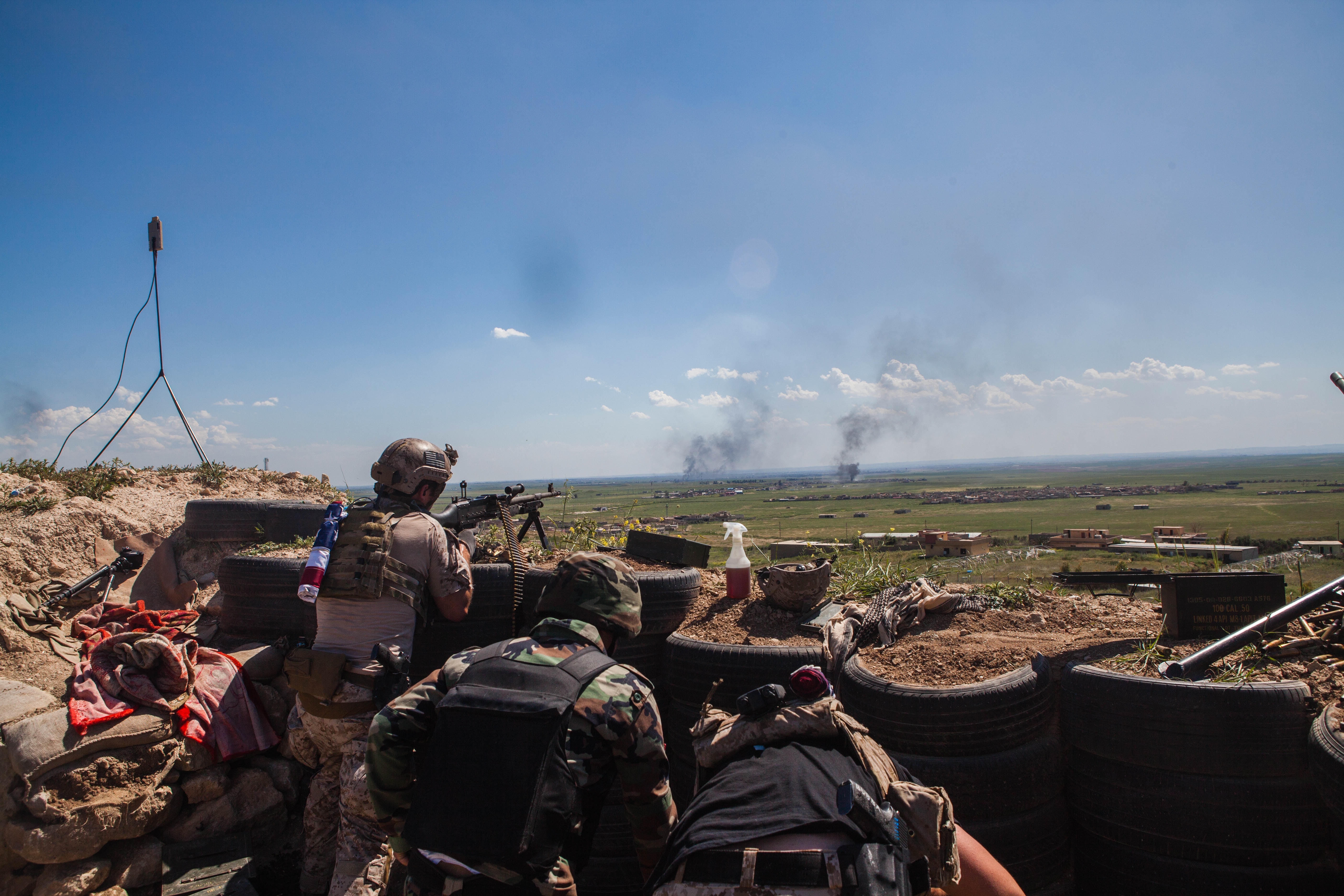
This month, a US drone attack on a nearby highway killed Shaker Wahib, the terrorists ‘military emir’ in Anbar, shaking morale. The day before the battle the United States dropped two huge bombs on minefields and berms surrounding the town.”
“Then came the attack from a combined force of Iraqi Army troops and hundreds of recently recruited tribal fighters who had been trained by US Special Operations Forces. When they moved in, only thirty Islamic State fighters stayed to fight.”
David Ignatius, “The U.S.’s Show of Power Against the Islamic State,” Washington Post, (March 2016)
ISIS meets Gypsy Caravan
In the summer of 2014, the Islamic State surged across the Syrian border into Northern Iraq, seizing Mosul almost without a fight. Beyond the city to its east, however, lay territory claimed by the Kurds; and here the Islamic State’s headlong advance foundered against a breakwater of Peshmerga defenses that surrounded Mosul on three sides. For the next eighteen months, Peshmerga and Islamic State fighters manned opposing trench lines only a few hundred meters apart in a scene reminiscent of the First World War.
Although halted in the North, the Islamic State continued to advance in Anbar province until it was just 30 miles from Baghdad, engulfing in its line of march places whose names evoked poignant memories for a generation of Marines: Al Qaim, Haditha, Fallujah, Karma, Ramadi—a heartbreaking litany of wasted effort.
In September, President Obama authorized the U.S. military to conduct air strikes in support of Iraqi and Kurdish security forces, and to deploy to Iraq a special operations task force. There was a strong undercurrent of urgency about the mission—everyone involved knew that it was entirely possible that the Islamic State could take Baghdad with one determined push. Incredibly, given the glacial machinations of the global force management process, a special operations task force appeared in Baghdad scarcely two weeks after the President’s announcement. It was an ad hoc affair, the hasty amalgamation of units already in theater: an Army Special Forces headquarters and a SEAL task group. Despite being, in the words of a British liaison officer, “somewhat of a gypsy caravan,” the task force was effective in halting the Islamic State’s inexorable advance.
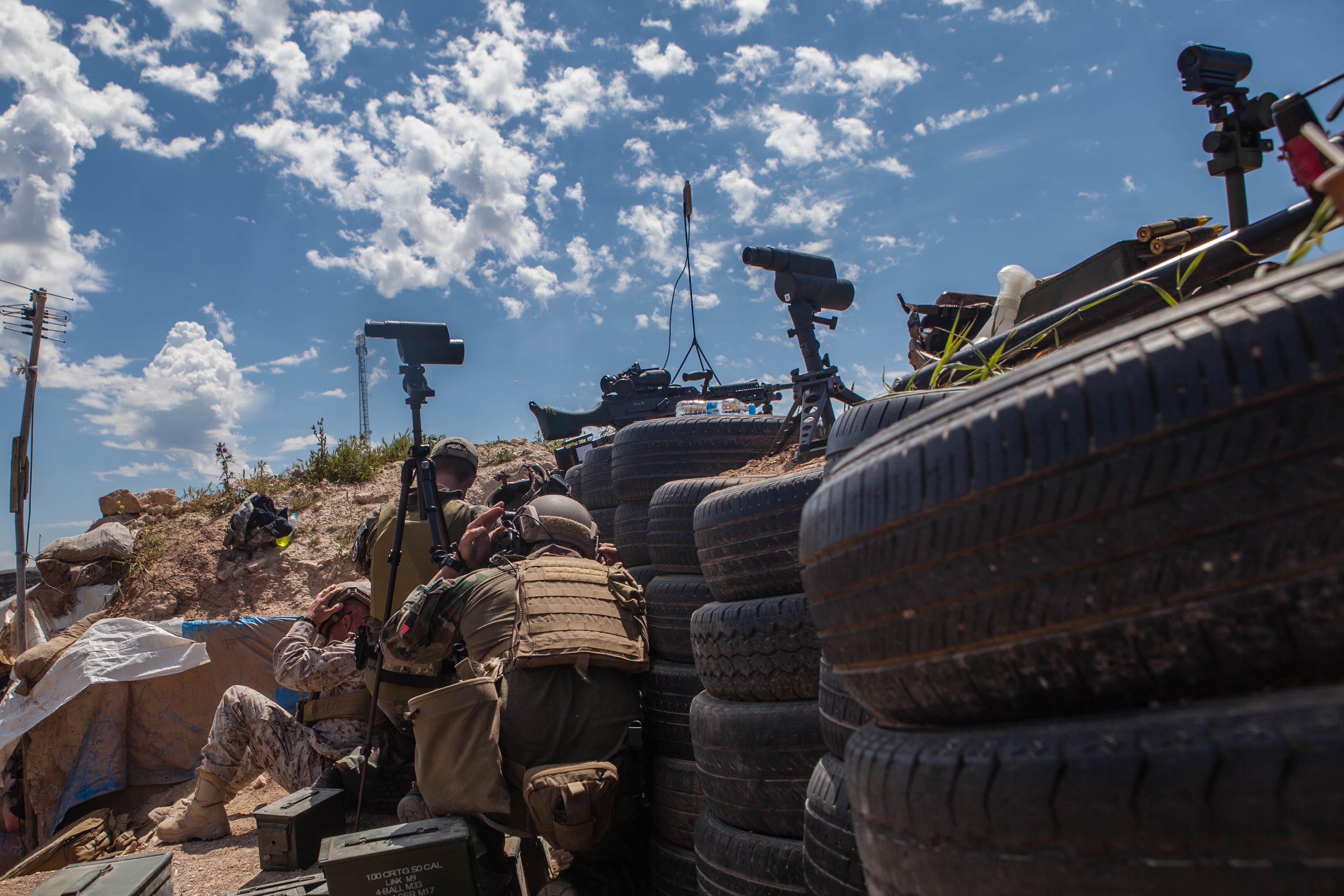 The Islamic State had no shortage of skilled rocketeers and were able to dial in on our OPs with impressive speed. Picture taken moments before first impact.
The Islamic State had no shortage of skilled rocketeers and were able to dial in on our OPs with impressive speed. Picture taken moments before first impact.Crisis and Opportunity
In December 2014, U.S. Special Operations Command put together a plan to replace this task force with another that would comprise a combined staff drawn from Naval Special War- fare Command and MARSOC. At the time, I commanded the Marine Raider Regiment and would soon switch roles to lead the first MARSOC rotation of this task force scheduled to deploy a year hence. It would be the first time that MARSOC had raised an 0-6 level special operations task force, and from the outset, all involved felt the pressure to succeed.
MARSOC is a small organization: comprising less than three percent of the United States Special Operations Command’s total manpower; it is a fifth the size of the Naval Special Warfare Command and less than a twelfth that of the U.S. Army’s Special Operations Command. Whereas there are five Army Special Forces Groups each with an 0-6 as both commander and deputy, there is only one Marine Raider Regiment headed by a single colonel. Because of this, our challenge was to figure out how to man a CJSOTF without closing shop at Camp Lejeune. The only way we could do this was to form the head- quarters from personnel drawn from across the SOF community and conventional forces. My primary staff were all individual augments with very little experience in their functional areas, and none had deployed before as part of a task force headquarters. Additionally, we were to include in the headquarters personnel from five different countries, which would pose endless challenges when it came to simply sharing information.
The six months that we had available for pre-deployment training shrank to five when we accounted for leave and public holidays—not a lot of time in which to train so disparate a group for a mission so complex.
Framing the Problem
This work-up would not resemble the preparation for previous deployments to Iraq or Afghanistan in which much was already known about the area of operations. The situation in Iraq was constantly changing as the Islamic State probed for weaknesses in the Peshmerga and Iraqi defenses while the various forces arrayed against it—Kurds, Iraqi Security Forces, Sunni Tribesmen, and Shia militia—jockeyed for position against each other as much as against the enemy.
It was July of 2015 when I assembled the CJSOTF staff together for the first time on the campus of the Joint Special Operations University in Tampa. There we underwent a two-week special operations planning course, which enabled us to develop our initial campaign plan.
This venue was our opportunity to frame the problem, a collective effort at sense making that gave us some shared understanding of an immensely com- plex situation.
Together, we examined the mysteries of doctrine, and despite the large number of unknowns, were able to give life to concepts such as mission analysis, implied tasks, assumptions, center of gravity and critical vulnerability. With the help of intelligence analysts, we were able to model a thinking enemy—put- ting ourselves in the position of the Islamic State as we discussed and then war gamed our approach.
The plan that resulted gave a frame of reference, a known point from which to shift as more information became available. I emphasized that we would have to re-assess this plan upon arrival in country—and thereafter as a continuous process.
Assessment involves much more than making PowerPoint charts that show easily measurable data with no necessary correlation to success (estimates of enemy casualties and equipment destroyed are a great example of this). A good unit incorporates assessment into their execution of operations. That assessment involves constantly asking the question “are we doing the right things. Is the energy that we are directing into the environment having the desired effect.” It is a continuous process—more art than science—and the commander has to be personally involved.
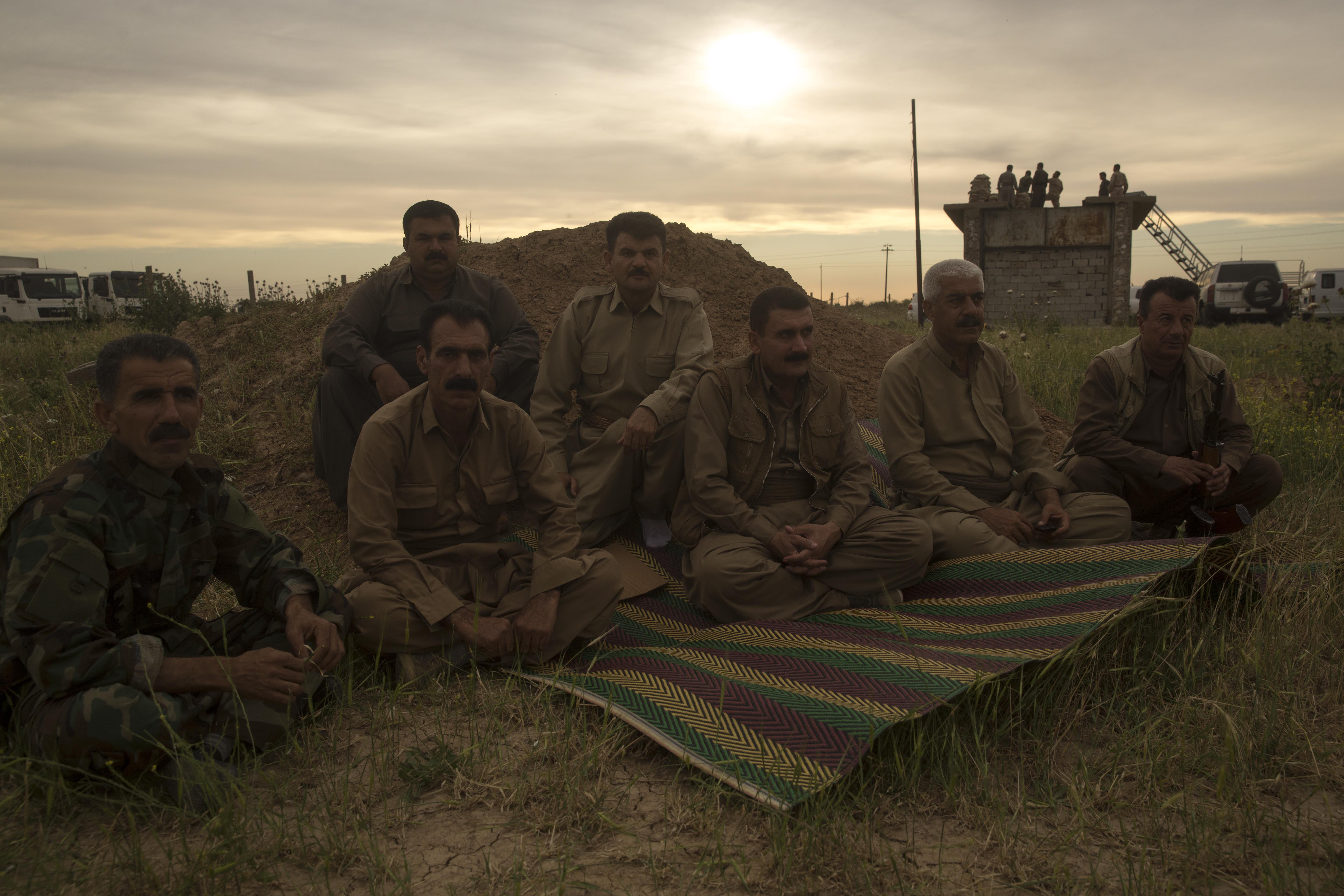 Peshmerga pray in the assembly area the night before the attack.
Peshmerga pray in the assembly area the night before the attack.An Impossible Span of Control
The Task Force deployed on New Year’s Day 2016 and was tasked with degrading, dismantling, and defeating ISIS—a mission that had a pleasing alliterative ring to it. This would be a countrywide campaign designed to undermine the enemy’s leadership and morale while systematically killing his foot soldiers and wresting back key terrain. Our ultimate goal was Mosul.
As CJSOTF commander, I commanded eight task forces, but only one of these—a Special Operations Task Force (SOTF), composed of SEALs—was large enough to conduct independent operations. The problem was that this SOTF had too many units spread over too wide an area to be able to manage them all effectively. Its geo- graphical span of control ranged from Anbar Province in Western Iraq to the Kurdish sector in the north. These were two distinct fights; the Iraqi and the Kurdish commanders fought the war against ISIS separately, as though they belonged to different countries, which in a real sense they did.
Our partnerships were all important, but at the same time, they were so diverse that we were compelled to make a separate line of operation for each one: the Peshmerga, the Iraqi SOF, and the Sunni Tribes. Each required different types of assistance and engagement— presenting a single commander with more than he would be able to handle effectively.
Realizing that I would need a second task force, I put in a request for a MAR- SOC task force to lead the campaign in the north—a request that stirred up no small amount of angst among cynics in the special operations enterprise who saw this as being a parochial bid on my part to get more Marines into the fight.
It would be five months before a MARSOC SOTF deployed to Erbil. In the meantime, I deputized an Army Special Forces lieutenant colonel on my CJSOTF staff and placed a MARSOC company headquarters below him. I then took roughly half the current SOTF’s strength—all those teams who were partnered with the Peshmerga—and placed them under this new headquarters. This arrangement was not initially popular with the various force providers involved, and I had to spend some time by SVTC getting buy-in from all stakeholders. After our CJSOTF left Iraq, MARSOC formalized this task organization by dedicating all three Raider battalions to the Iraq SOTF rotation.
Leading Up
The CJSOTF was the only U.S. unit in Iraq that had the permissions and freedom of movement that enabled it to partner those forces that were involved in direct combat with ISIS: the Peshmerga, Iraqi SOF, and Sunni Tribes. Conventional units were much more restricted in what they could do and lacked cohesive relationships with the Iraqi Army and Peshmerga. Further- more, they were not permitted to have a direct relationship to the Sunni Tribes whose cooperation would be critical plan to win back Anbar Province—the Iraqi Government’s first geographic priority in the fight against ISIS.
Typically, when a subordinate unit is best positioned to have an impact on the enemy, it makes sense for higher headquarters to make this unit the main effort. In terms of command relation- ships, this unit becomes the supported unit with all other units being designated as supporting.
But as CJSOTF commander, I was supporting the Combined Joint Force Land Component (CJFLC), which comprised a conventional army division headquarters, heavy with generals and determined to make a name for itself in the counter-ISIS fight. The division had twice as many personnel on its headquarters staff alone as we had in the entire CJSOTF. It was only half in jest that I would modify a famous Churchillian quote to apply to this top- heavy arrangement: “Never in the field of human conflict have so few been led by so many.”
Ultimately, the relationship worked but not without considerable friction— something that I might have been able to mitigate had I devoted as much effort to leading up, as I did to leading down.
Leading Down
In contrast, I could not have been happier with performance of the eight task forces that worked for me, from the larger Canadian and Australian contributions to the smaller detachments from Holland, Norway, Belgium, France, Sweden, Italy, and Spain—each brought distinctive capabilities and were eager to contribute. I never once ran into a situation where a subordinate commander pulled the red card on me, indicating a conflict between my orders and his national chain of command. At times, I was not beyond using their national authorities to circumvent the burden- some restrictions placed on U.S. units.
In one such case, the CJSOTF was forbidden to support a particular Iraqi SOF unit, the Emergency Response Division, because of that unit’s alleged Shia affiliations. During the battle to re-take Fallujah, this prohibition was problematic because the ERD was the Iraqi Army’s main effort for much of the battle. Fortunately, the Italian SOF task force was encouraged by their national chain of command to partner with the ERD. So—using Italian fire support teams—the CJSOTF was able to deliver fires in a manner that avoided the perception of direct support but enabled the ERD to make headway into the city.
Partners
Everything that we did in Iraq would have to be by, with, and through our partners—which made them our operational center of gravity.
We had three main partners who bore the brunt of the fighting against the Islamic State. First, there was the Counter Terrorism Brigade which spearheaded every Iraqi Army operation in the role of elite infantry, sustaining heavy casualties as a result. Then there was the Peshmerga who had stopped the Islamic State’s advance in the North and, for the previous two years, held them to a limit of advance that extended several hundred kilometers across northern Iraq. Our third partner force comprised some 10,000 Sunni tribesmen whom we were tasked with recruiting and training in Anbar province with the uneasy assistance of the Iraqi government.
Without Iraqi SOF, there could be no drive north from Baghdad up the Tigris valley. Without the Peshmerga, there would be nothing in the meantime to stop the Islamic State from sweeping southwards from Mosul. And without the support of the tribes in Anbar there could be little hope of dislodging the Islamic State from that key province.
At the same time, all of us in the CJSOTF had to be aware of political sensitivities that attended each one of these relationships and become adept in navigating them.
The Peshmerga and the Iraqi government were openly hostile to one an- other. The Peshmerga, who had long sought their own independent state in the north and had since the First Gulf war, settled instead on the Iraqi government’s agreement to a semi-autonomous region. Following the fall of Mosul, the collapse of the Iraqi Army, and the Peshmerga’s successful bid to halt the Islamic State’s advance in the North, the Peshmerga believed that they had won their right to a homeland. The Iraqi government of course was not about to cede the most fertile and oil rich portion of the country to the Kurds. So even while the fight against ISIS was taking place, this enmity bubbled beneath the surface, on occasion erupting into open hostility such as when the Iraqis would refuse to support Peshmerga offensives against ISIS. On one occasion that I witnessed, the Iraqi air force bombed Kurdish positions claiming afterwards that it had been an error.
As for the Sunni Tribes, there was a great deal of mutual distrust between them and the predominantly Shia Iraq government—who were always uneasy about the U.S. SOF effort to arm and train the tribesmen.
In short, this was the kind of environment that even the most imaginative exercise scripters would have struggled to produce—and yet probably a good representation of the reality that U.S. forces can expect to face.
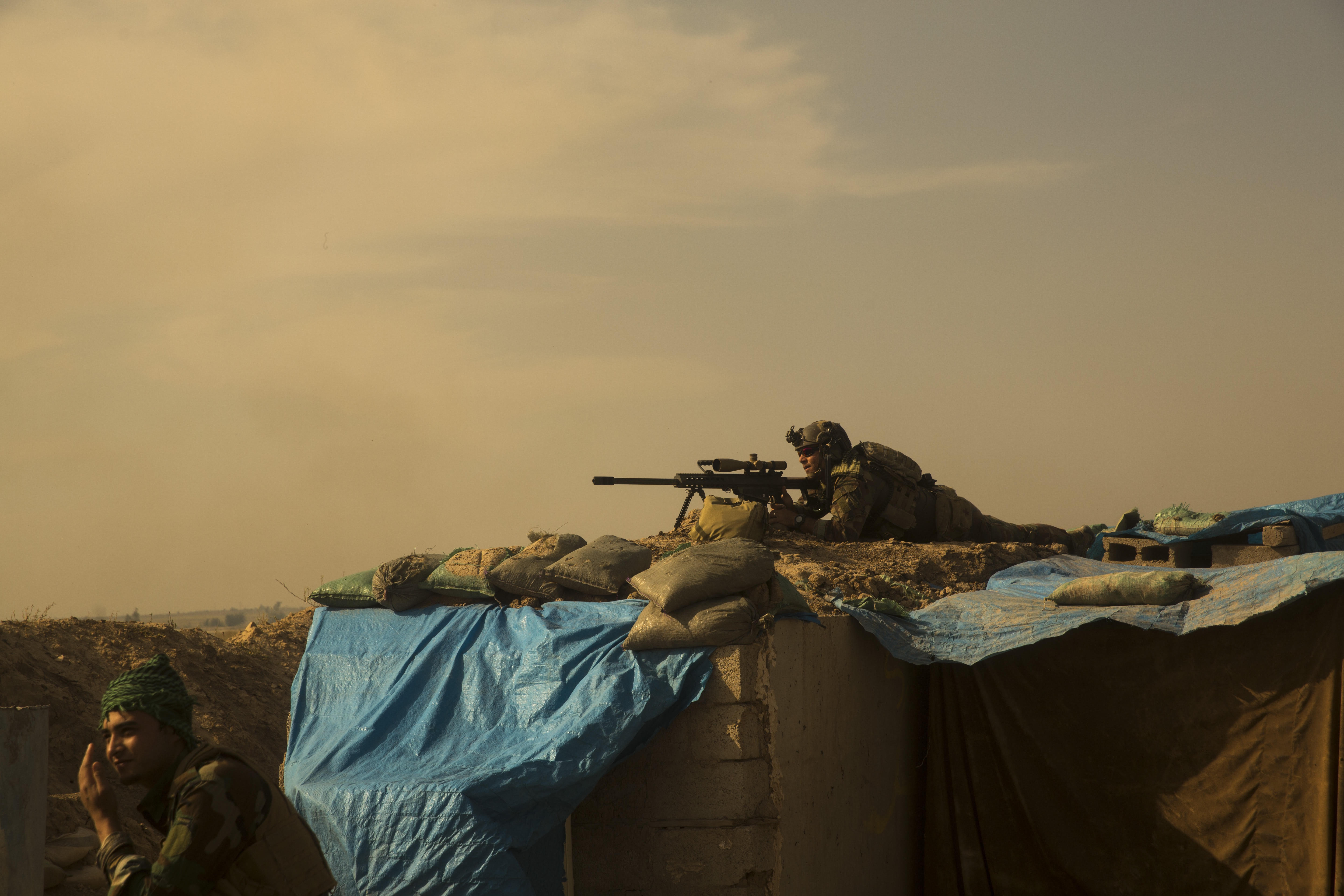 A Marine Raider provides covering fire for a Peshmerga attack.
A Marine Raider provides covering fire for a Peshmerga attack.Modeling A Thinking Enemy
The Islamic State had steadily gained territory over the course of the previous year, and now, with over a third of the country under its control, was only 30 miles from Baghdad. As we arrived, Iraqi Special Operations Forces were leading an attack to reclaim Ramadi in a block-by-block slugging match that dragged on for almost three months. Even with Ramadi back in government hands, ISIS still held the vast majority of Anbar Province and had the benefit of fighting closer to the Iraqi capital than to its own.
The Islamic State’s operational center of gravity was its army—its order of battle which consisted of actual units of fighters with a fairly sophisticated command and control (C2) and logistic support structure. It was this army that enabled ISIS to capture and hold territory to establish itself as a Caliphate—the essence of its identity and the means by which it was able to attract a steady flow of recruits. If we could destroy this army, killing the Islamic State’s foot soldiers at a rate faster than they could be replenished by the flow of recruits coming across the border from Syria, we would win.
But once we were in country, we realized that the pursuing the enemy’s operational center of gravity would entail a lengthy war of attrition. We could kill Baghdadi’s foot soldiers all day, and it would make no difference as long as he continued to draw recruits from across the Muslim diaspora. At the rate that the Iraqi security forces were clawing back territory, it would take two more bloody years to reach Mosul.
While the Iraqi security forces were focused on the fight in Anbar, we needed to make ISIS feel pressure closer to home. We would continue to support our partners as they fought toe-to-toe with the enemy, but to have strategic effect (which should always be the objective of special operations forces), we needed to focus our efforts on the enemy’s strategic center of gravity.
Mosul was the physical and spiritual epicenter of the Islamic State. It was the location from which Al Bakr Baghdadi had declared the birth of the Caliphate in June 2014. Since then, it had been the beacon that had drawn recruits from across the Muslim diaspora to serve un- der the black flag. Mosul was the source of the Islamic State’s moral strength, and in war—as Napoleon famously said—the moral is to the physical as ten is to one. Mosul was where we were going to use that principle to even the score.
The population of Mosul—some one million inhabitants—vastly out- numbered the Islamic State fighters in the city. In order to hold on to Mosul, the Islamic State would have to secure their continued compliance. To do this, they would have to make good on their explicit mandate to represent a proto- state by providing the governance and services that the inhabitants of any city require. Failing this, they would have to resort to draconian measures to maintain order, which would likely incur resentment, especially if this dissatisfaction was fueled by a coherent U.S. information campaign. At the same time, we had to offer the predominantly Sunni inhabitants of Mosul a credible and acceptable alternative. We would only win their confidence by showing them that ISIS would not simply be replaced by an occupying Shia army.
Our partnership with the Iraqi Special Operations Forces meant that we still had to focus on defeating Islamic State fighters in the field. ISIS had no shortage of savvy tactical commanders—men who were able to execute impressive C2 without all the tools available to western armies. They were adept at planning and executing offensive operations and were particularly good at rapidly bringing together cohesive counterattacks. They typically used vehicle borne IEDs converging on point of penetration or, in the case of counter- attack, against our lead elements. Time and again, ISIS units fought with great determination often to the last man—as long as they had this kind of direction.
Morale is an interesting thing. In the case of the ISIS rank and file, there was no straight-line correlation between morale and expectation of survival. Again and again, we saw Islamic State units fight with a happy heart though all hands faced almost certain death, but there was a connection between morale and leadership: the presence of a commander, whose proficiency and charisma lent meaning to their sacrifice, was all important. Remove that—take away the calm voice on the radio—and even foreign fighters, typically more fanatical than their home-grown comrades, were likely to evaporate in the face of determined attack.
Armed with this knowledge, we made a point of removing from play as many tactical leaders as we could immediately prior to an operation—a move that clearly undermined the enemy’s will to fight in the battles to re-capture Fallujah and Rutbah.
Emerald Bounty
Joint doctrine directs you to find the enemy’s critical vulnerability, the chink in his armor that will tip him off-balance and bring him down. In practice, it is not so clear cut; if the enemy does have a critical vulnerability, it is seldom apparent. So, you look for a range of vulnerabilities and work on them all simultaneously, ready to exploit success.
All of this was easy to say but much harder to make a reality. Fortunately, I had the right team: a brainy cabal of junior officers: Marines, Green Berets, SEALs, Australians, and Brits who put together in short order an ingenious but simple plan. In its essence, it involved loosening the Islamic State’s grip on Mosul simultaneously from inside and out, in a manner designed to elicit an atavistic reaction from its leadership, and while offering to Mosul’s long- suffering inhabitants the message that help was on its way.
We called this Operation EMERALD BOUNTY. The origin of this name was like the clue to a crossword puzzle. Emerald City was our term for Mosul, and Bounty was a play on the word’s actual meaning as a prize and its connection with the term mutiny—as in Mutiny on the Bounty. Inciting mutiny—or more accurately, revolt—would be one method by which we proposed to win Mosul back.
That is what our campaign was designed to do. I did not think for a moment that any one of our initiatives under EMERALD BOUNTY would be the silver bullet to bring the Islamic State to its knees, but in their aggregate, I was confident that they would have an effect—enabling the Iraqis to take Mosul earlier and at less cost than would otherwise be the case.
UW by FaceTime
Looking for vulnerabilities inside Mosul would mean working with disaffected members of the local population, of which there were many. The Islamic State’s failure to deliver on the basic obligations of civil government while imposing their medieval version of the rule of law had alienated the city’s population. The question was whether they had been cowed into submission or were angry enough to take action.
Inciting segments of the population in Mosul to revolt without having direct contact with them would be a challenge. The initial contact relationship building and recruitment (if that is the right term) would all have to be conducted by means of the internet. It takes extraordinarily talented people to persuade others, whom they have never met, to rebel against an occupying force at the risk of their lives. Furthermore. it takes a good understanding of group psychology: that it is best to start with small acts of defiance, graffiti, or minor vandalism for instance, even if their contribution to your objectives may appear insignificant. Once someone takes that initial step, it becomes easier to persuade them to do more. In this we were enabled by ISIS, who punished all acts of defiance in the same draconian manner—bringing to mind the old English proverb “You might as well be hanged for a sheep as for a lamb.”
Our inside approach also included using advanced targeting methods to identify and take out the Islamic State’s mid-level managers. Killing the top people of an organization like ISIS or Al Qaeda, while satisfying, achieves little in the long run and can even make things worse than before. On the other hand, if we could take out of play the people whose expertise Daesh depended on, the men who really ran the organization and commanded its units in the field, then—so we reasoned—we had a better chance of causing real damage.
The Enemy of my Enemy
To exert pressure from outside the city, we needed to find a group of Sunnis to conduct raids into Mosul’s outskirts. The majority of Mosul’s population were more fearful of a vengeful Shia liberation than they were of ISIS. We needed to show them that their fellow Sunnis were taking action, however symbolic, to challenge the Islamic State’s grip on the city. ISIS had only been partially effective in eliminating use of the internet in Mosul, and we knew that such news would travel fast.
We were not looking for a relief force—just a group of fighters who could strike and then withdraw. We found just such a group had already been formed by the former governor of Mosul, a man named Atheel Najaifi, and we reached out to him to see if we could enlist his help in our scheme. However, as we began negotiations, our intelligence team discovered that Najaifi was affiliated with a Sunni extremist group, the Nachabandi, who had ties with the Islamic State. We circumvented this problem by persuading Najaifi to turn over his group of Sunni tribesmen for us to train, advise, and assist—and so EMERALD BOUNTY was born.
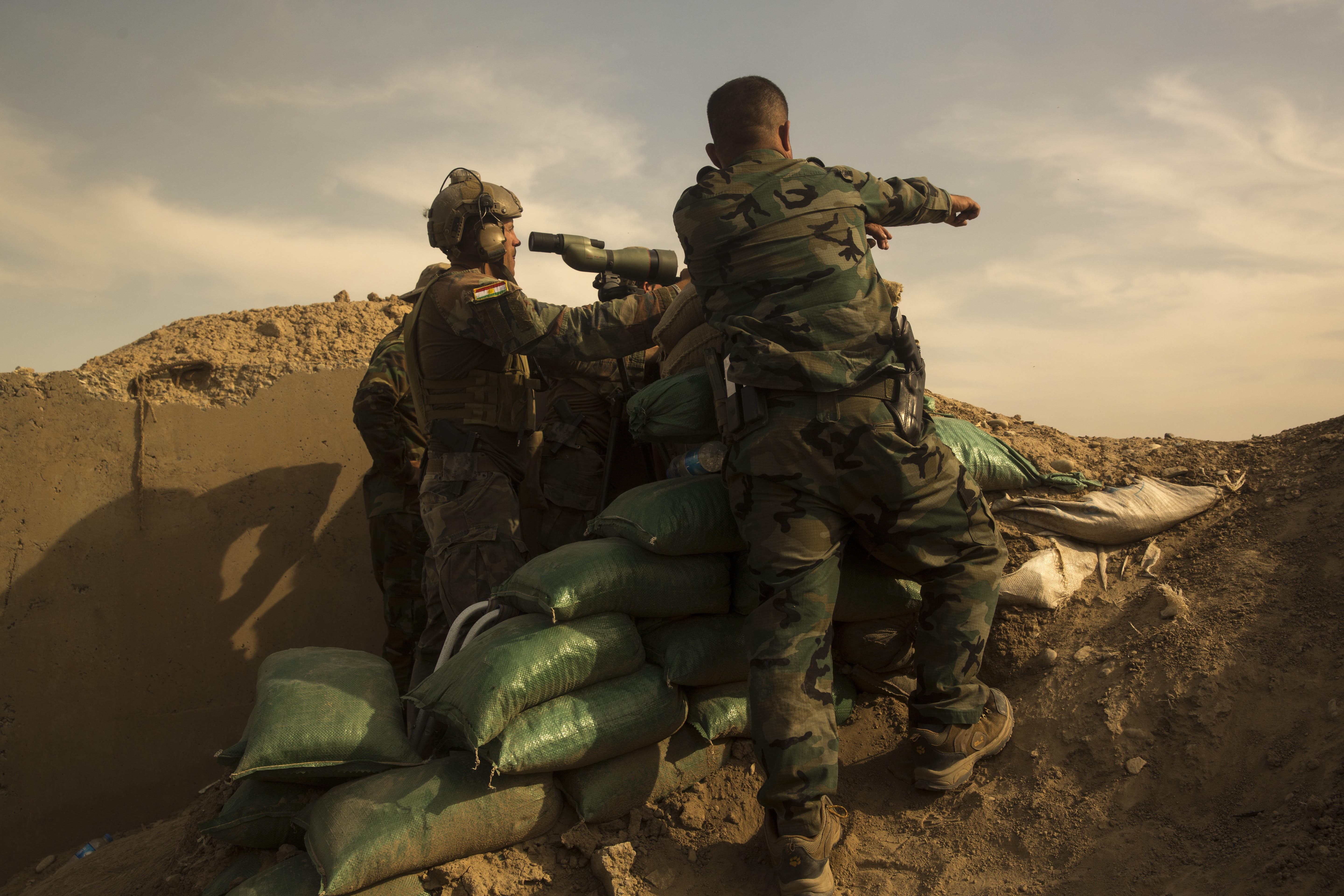 A Peshmerga officer points out targets to a Raider JTAC.
A Peshmerga officer points out targets to a Raider JTAC.The Kill Chain as King
The term “kill chain” is a military concept used to describe the process of an attack. It consists of initial target identification, a “fixing” phase which involves determining a target’s location and other relevant details while preparing to strike, the final decision and order to attack, and—finally—the destruction of the target. The term is used for any method of attack whether launched by drones, manned aircraft, artillery, or a ground force. It is also used to describe operations in the information or cyber environment. The more efficient the kill chain becomes, the less advantageous it renders traditional forms of maneuver involving ground-mobile units.
The campaign against the Islamic State was an introduction for us to the primacy of the kill chain in modern war. Given our mandate to avoid where possible direct contact with the enemy and our reliance on precision fires, the use of sensors—primarily airborne drones—became all important. For the CJSOTF—sensing meant not just visual observation but also the use of signals intelligence to locate and validate targets. In turn the Islamic State also used drones to initiate kill chains—a tactic that it employed with increasing sophistication.
The requirement to employ responsive sensors as part of a functioning kill chain is even more acute now for Marine ground combat units preparing to take on Chinese forces in Indo-PACOM. Even the humble Puma, equipped only with electro-optical cameras, has—in the hands of a skilled operator—become worth its weight in gold.
Conclusion
By the time the MARSOC led CJSOTF turned over to its successor in July 2016, the area of Iraq under control of the Islamic State had shrunk to less than half its size at the beginning of our deployment and the Iraqi Security Forces had started to push towards the outskirts of Mosul. It was, of course, a combined effort, heavily dependent on all the resources that the Coalition was able to bring to bear.
The campaign against ISIS brought to war fighting a new dimension: the ubiquitous employment of drones by both sides, for instance, and the use of the internet as a medium for psychological operations, intelligence collection, and for recruiting surrogate forces from among the population in enemy territory.
The ability to employ proxy forces and to raise and train armed resistance groups against adversary states or proto states are areas of expertise likely to increase rather than diminish in value in this era of Great Power Competition.
It is true that the unique capabilities of SOF enabled the CJSOTF to make a contribution out of proportion to its size, but the advantages that we had in terms of training, and equipment are easily accessible now by conventional Marine ground combat units. The ability to employ multiple sensors and to link them rapidly to precision fires is not a skill that should be the exclusive use of special operations forces. The integration of effects in the electro-magnetic spectrum simply involves a wider view of the concept of combined arms that is already central to the way we fight.
If we are to operate below the threshold of detectable electronic emissions, we really need to take seriously concepts such as commander’s intent, implicit communication and – of course – that much discussed and universally neglected principle: mission command
As prosaic though it may sound, the fundamentals that enable us to adapt to the changing nature of war are already rooted in our doctrine. If only we could adhere to it.
No comments:
Post a Comment